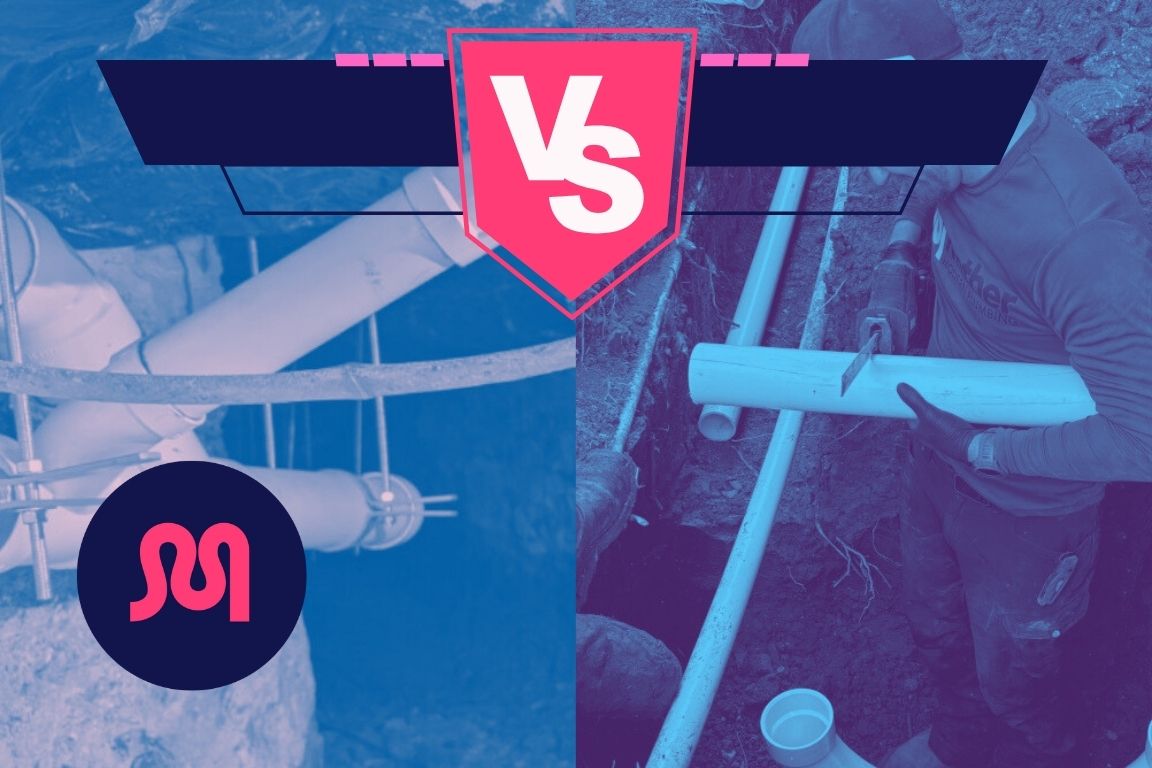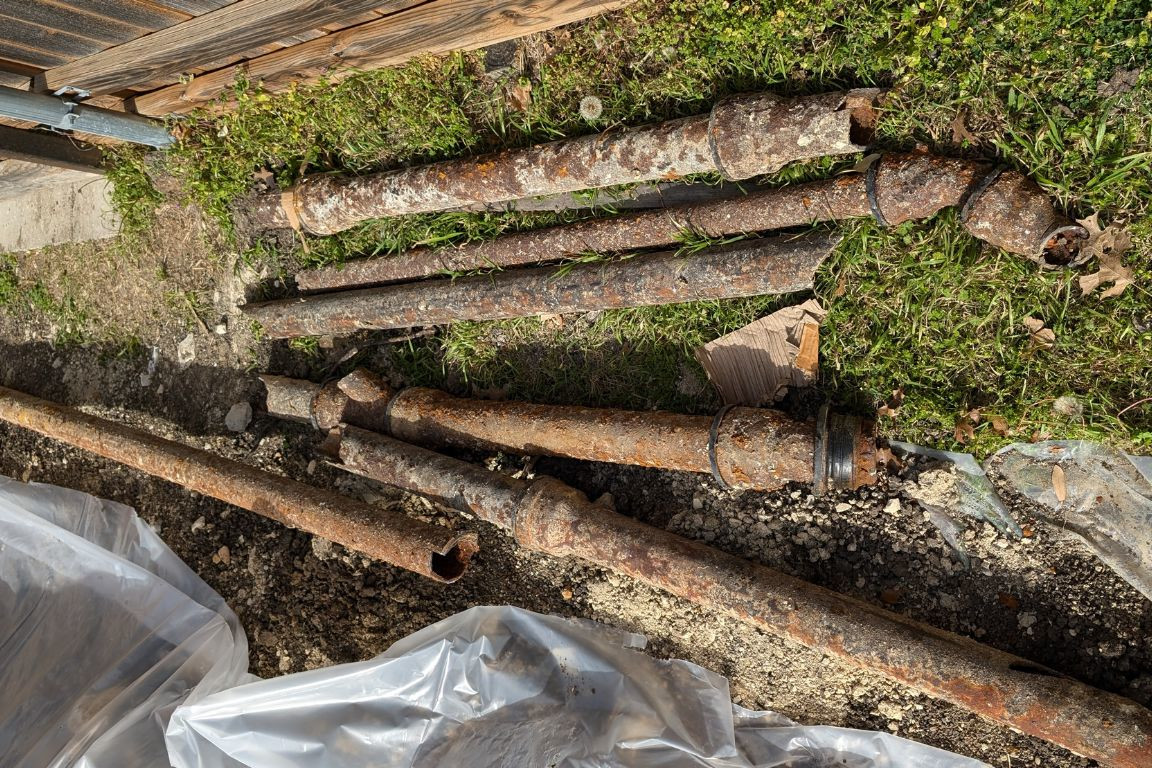Comparing Full Sewer Line Replacement vs Pipe Rerouting

table of contents
table of contents
There’s no way around it — a burst sewer pipe or sewer line collapse requires a total replacement. But you’re worried about portions of your pipe that travel dangerously close to your slab foundation. Should you choose to replace or reroute your main sewer line?
The answer is all about location — where your damaged sewer pipes exist dictates the right decision for you.
We train our plumbers to identify the exact cause of your sewer issue, compare your repair options, and establish the single best solution to the problem. This is the advice we give our customers — and we wrote it up in a homeowner’s guide for you.
We train our plumbers to identify the exact cause of your sewer issue, compare your repair options, and establish the single best solution to the problem. This is the advice we give our customers — and we wrote it up in a homeowner’s guide for you.
We’re Mother — a Dallas based plumbing company founded on modern service options and long-term solutions. Our research team and Master Plumbers built this comparison guide for homeowners to compare their sewer repair options and choose the best quote for their project.
Live in Dallas and need a second opinion on sewer repairs? Call us 7 days a week for expert, timely service.
{{sewer-line-repair-and-replacement="/services/sewer-line-repair-and-replacement"}}
The 5 Sewer Line Problems Influencing Your Repair Decision

If you’re choosing between full sewer line replacement or pipe rerouting, then you’re dealing with these 5 common sewer repair issues:
- Multiple separations in your sewer line
- Sewer bellies in multiple locations
- Burst sewer pipe
- Sewer line collapse
- A pipe leak in or under your foundation
Homeowners choosing between these 2 sewer repair options have extensive pipe damage, usually a 50 foot section or longer.
If your damaged pipe section is between 10-50 feet and located nowhere near your foundation, you’re probably better off with partial sewer line replacement.
Need a different solution? Compare your choices in our comprehensive guide to Dallas sewer repair options.
{{best-dallas-sewer-repair-options="/blogs/best-dallas-sewer-repair-options"}}
When to Choose Full Sewer Line Replacement vs Pipe Rerouting
First a quick overview of each kind of repair:
Full sewer line replacement means we're replacing the entire length of your sewer pipe, from under your home's foundation all the way to the municipal connection or your septic tank.
Pipe rerouting involves abandoning the old, problematic sewer line and installing a brand-new pipe along an entirely different, more practical path.
Side-by-Side Comparison Table: Partial Replacement vs. Full Replacement
*Note: Costs are estimates and can vary widely based on pipe depth, location (e.g., under concrete), soil conditions, and specific DFW market factors.
Full Sewer Line Replacement: 50+ Feet of Damaged Pipes

Complete sewer line replacement is typically done when the entire line is extensively damaged or has reached the end of its lifespan.
As a general rule of thumb, replacing your entire sewer line is the best course of action when 50+ feet of your pipe is damaged.
What’s involved in the repair process: First, our plumbers conduct extensive excavation along the entire sewer line path. Extreme care is taken to reduce damage to existing landscaping, driveways and foundations. The entire existing pipe is disconnected and removed.
A new, complete sewer line is installed in the existing trench using new Schedule 40 PVC, offering a lifespan up to 100 years with regular maintenance. The new line is connected and rigorously tested for proper seals and joints.
Finally, complete backfilling occurs to restore your affected yard to its original state. This includes remediation of your landscaping and hardscape areas.
- Pros:
- Replaces the entire existing sewer line, providing a completely new Schedule 40 PVC sewer line.
- No existing pipe sections remain in place — this “resets the clock” on your sewer system’s lifespan.
- Full, restorative peace of mind, with a solution that resolves all existing sewer line repair issues.
- Cons:
- The most complex and expensive of all sewer repair options due to project scope and labor intensity.
- Invasive digging will likely affect landscaping and hardscape areas, and may require work in and around your foundation.
Sewer Pipe Rerouting: A New Pathway for Problem Spots

Pipe rerouting allows your plumber to bypass areas where the existing pipe is hard to reach, and create a more accessible new layout for your sewer line.
What’s involved in the repair process: We start with a sewer camera inspection of your existing sewer line to confirm its condition, pinpoint the issues (like repeated breaks, collapses, or inaccessibility), and precisely map out its current route. Then, we identify the most efficient path that avoids current or future obstacles.
The problematic sections of your old sewer line are carefully disconnected from your home's internal plumbing system — if they’re in an inaccessible area, they’re often left in place. Finally, we lay the new, durable Schedule 40 PVC pipe. Each section is securely connected and graded at the correct slope to guarantee uninterrupted gravity flow of wastewater.
- Pros:
- Accesses and replaces damaged pipe sections in hard-to-reach areas, especially under foundations and major landscaping.
- Provides a new pathway for your sewer system with an unproblematic layout, making future repairs easier.
- A quality option for home renovations — adjust your layout as you relocate plumbing fixtures.
- Cons:
- New trenches must be created to lay new pipe sections.
- Unnecessary if direct access to your damaged pipe section is possible.
When to Choose Full Sewer Line Replacement
Complete replacement of your sewer line is the best option when all other sewer repair options fail to address extensive issues or systemic failure — it’s time to “hit reset” on your sewer line.
Real-life customer scenarios where pipe rerouting is the better choice:
- A complete pipe collapse makes total replacement necessary: Our sewer camera inspection revealed a systemic collapse over 50 feet in length, making partial sewer line replacement ineffective.
- The existing pipe materials are outdated and have failed: We noted extensive corrosion, multiple penetrations and 2 separations throughout an existing cast iron sewer pipe.
When not to choose full replacement: If you don’t have to replace your entire main sewer line, consider partial replacement instead. Be advised that you’ll retain some older pipe sections if you do — but you’ll save thousands in project costs.
If your collapsed sewer line travels underneath your home’s foundation, ask your plumber about pipe rerouting options. It may be a safer long-term option for your home’s structure to lay a new pipe around your foundation instead of digging through or under it.
When to Choose Pipe Rerouting
Pipe rerouting allows for a completely fresh start for your wastewater drainage, avoiding the ongoing issues and disruption associated with repeatedly fixing a problematic original route. It's a strategic way to provide a long-term, reliable sewer solution by creating a new, optimized pathway.
Real-life customer scenarios where pipe rerouting is the better choice:
- A damaged pipe section runs under your slab foundation: A fresh Schedule 40 PVC sewer pipe section with a pathway around your foundation saves costly, invasive slab breaks to fix the existing issue.
- A damaged sewer pipe exists under major landscaping: Spare the expense of digging up and replacing landscaping and reroute the pipe section.
- New construction sits atop your old pipe section: A home addition or renovation built over a damaged sewer pipe often makes rerouting more practical than tunneling for repairs — especially if you’re already relocating taps and plumbing fixtures.
When not to choose rerouting: Don’t choose pipe rerouting when a more straightforward, less disruptive, and potentially more cost-effective repair or replacement option is truly viable for the actual problem.
For instance, if the issue is a single, isolated break in an otherwise healthy pipe in an easily accessible area, a spot repair would be far more sensible.
If your damaged sewer pipe is easily accessible, a straightforward partial replacement is more sensible than rerouting the entire section.
What’s your project going to cost? Get current answers on local pricing in our updated Dallas sewer line repair and replacement cost guide.
{{main-sewage-line-replacement-best-texas-guide="/blogs/main-sewage-line-replacement-best-texas-guide"}}
✅ Mother Modern Plumbing’s Recommendation

Ultimately, choosing between complete sewer replacement and pipe rerouting is all about layout — is accessing and replacing your damaged pipe easy, or highly intrusive?
Choose full sewer line replacement when your damaged pipe is beyond partial repairs (usually 50+ feet of damage), and you don’t need an alternate route around your foundation or large hardscape area (driveways, patio).
Choose pipe rerouting when your damaged pipe section is inaccessible, and direct repairs would create costly disruptions to your foundation, hardscape or additions/extensions.
TABLE: Full Sewer Line Replacement vs. Pipe Rerouting Use Cases
📞 Call Mother for Dallas Sewer Line Repair and Replacement
Still not sure which repair is right for your Dallas home? Worried your current plumbing quotes are too high, too invasive or incomplete?
Call Mother for a thorough inspection of your Dallas sewer line. We’ll identify the problem with our non-invasive sewer camera inspection and hydrostatic testing services. Then, we’ll walk you through the pros and cons of each service option in simple terms, with no pressure.
Whether you need simple spot repairs, a complete sewer line replacement, or a fresh reroute of your pipes, trust our plumbing experts for an honest second opinion and a long-term solution for your home.
{{sewer-line-repair-and-replacement="/services/sewer-line-repair-and-replacement"}}
Common Q’s about Drain & Sewer
Is sewer line replacement covered by insurance?
Homeowner's insurance typically doesn't cover general wear and tear or maintenance issues. However, if the damage was caused by a sudden, accidental event (like a vehicle crushing the pipe, or a specific tree falling on it), there might be some coverage. It's always best to check with your specific insurance provider.
How long will my new sewer pipe section last?
We install new sections of Schedule 40 PVC pipe for spot repairs and partial sewer line replacements. Schedule 40 PVC is designed to last up to 100 years.
The lifespan of the entire system will depend on the remaining old pipe, which could still develop problems.
How long does full sewer line replacement take?
Full sewer line replacement takes 5-8 days, depending on the length of your damaged pipe section, how deep it’s buried in your yard, and if it travels near your home’s foundation.
How long does pipe rerouting take?
Expect most pipe rerouting projects to take between 3-7 days, depending on the severity of your pipe damage and its exact location (under a foundation, landscaping, etc.)
Is rerouting plumbing a good idea?
Yes, rerouting your pipes is a good idea — especially if your existing damaged pipes are underneath your slab foundation. You’ll avoid breaking the concrete slab to conduct repairs, and the location of your new pipe makes future plumbing repairs easier.
What pipe material is best for sewer line replacement?
Your plumber should use Schedule 40 PVC for all sewer line replacement projects. Schedule 40 PVC offers stronger durability, chemical resistance, and anti-corrosive properties than other sewer pipe materials.
When is sewer line rerouting the best option?
Choose to reroute your sewer line (instead of pipe replacement) when you encounter these five scenarios:
- The existing sewer line is near or under your slab foundation
- The sewer line is in a hard-to-reach or inaccessible location
- The cost of future repairs is highly reduced by rerouting
- Sewer line replacement would involve breaking your concrete slab or heavily damaging your floors
- The existing sewer line path fundamentally limits a desired addition or extension




